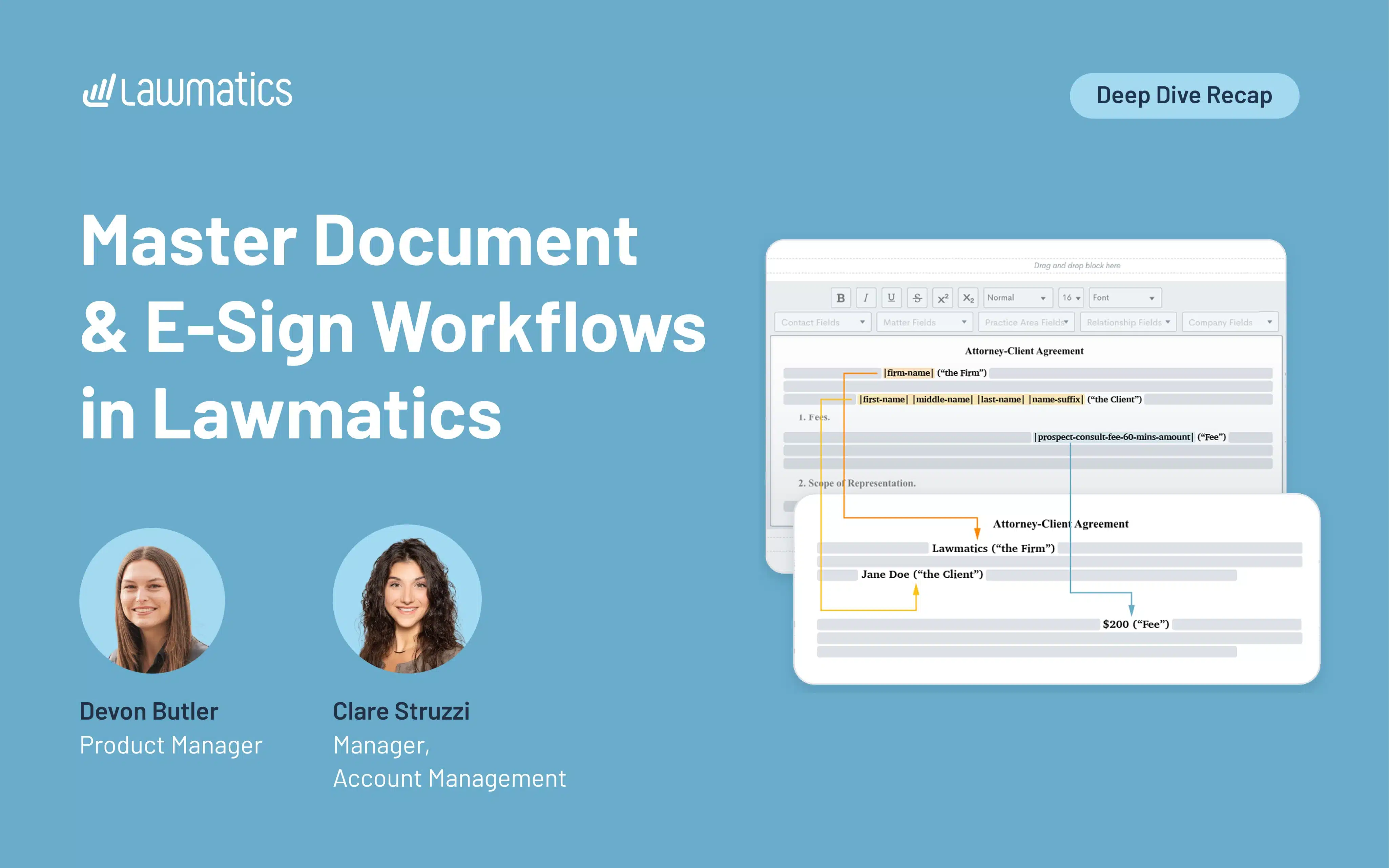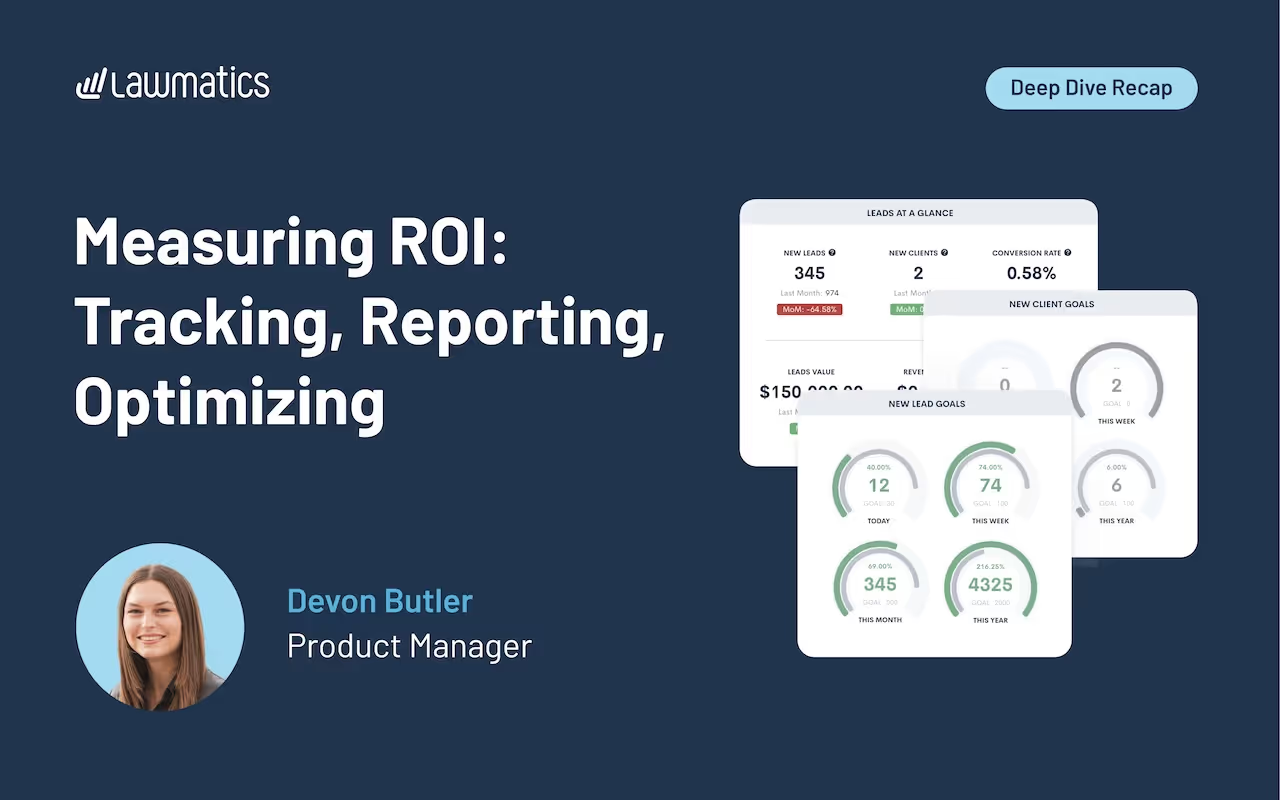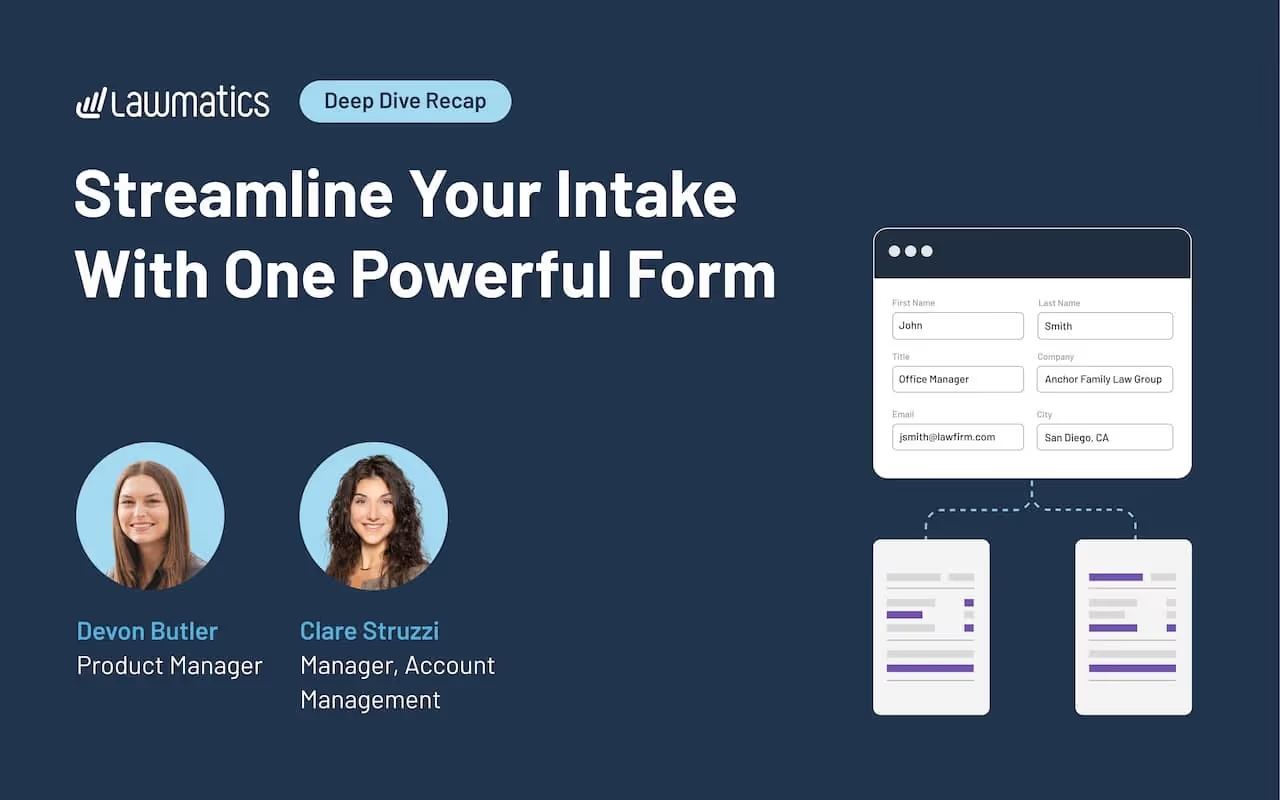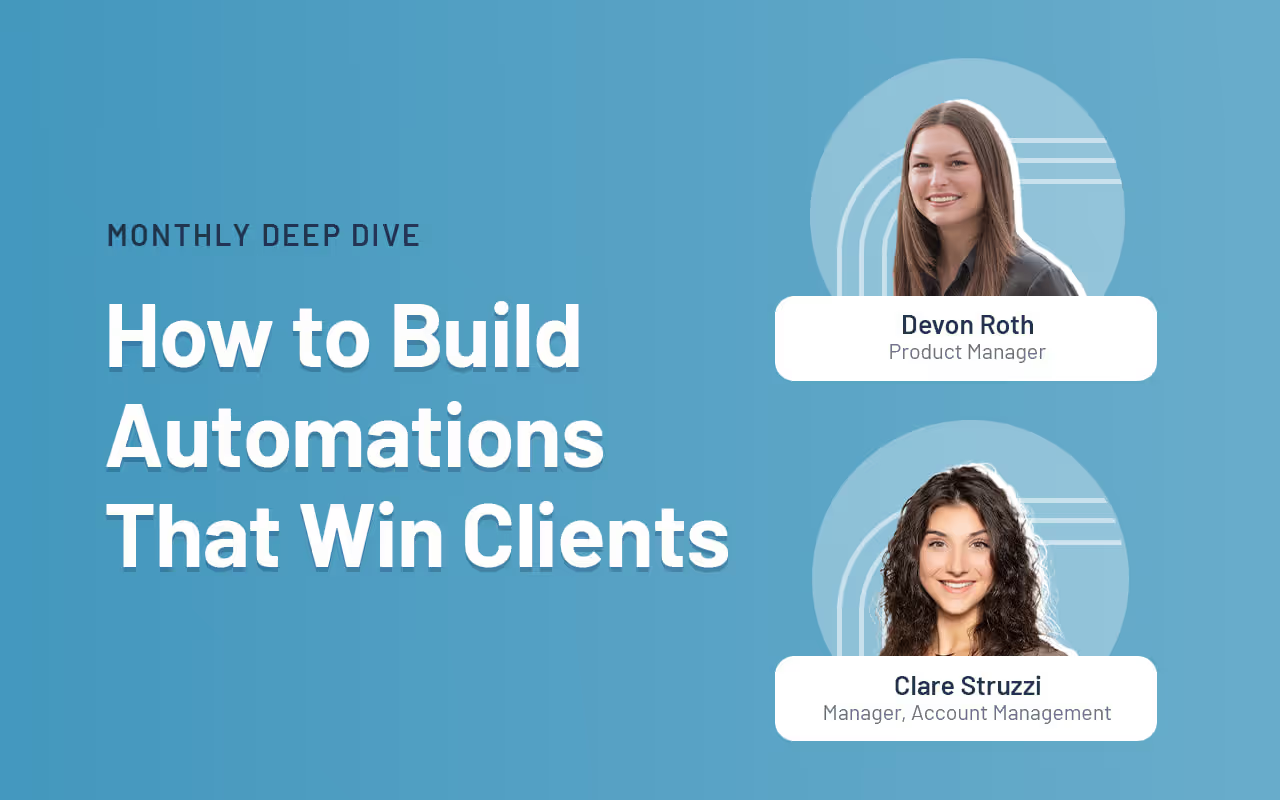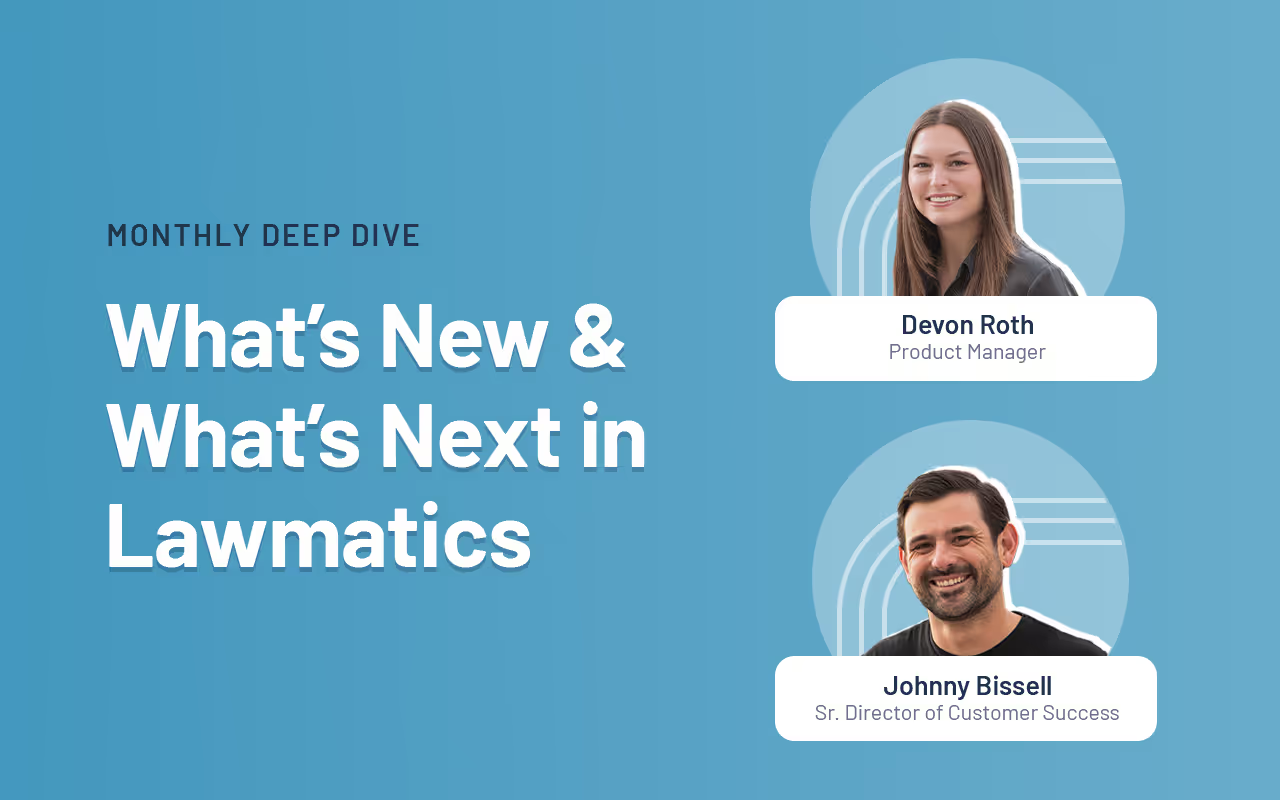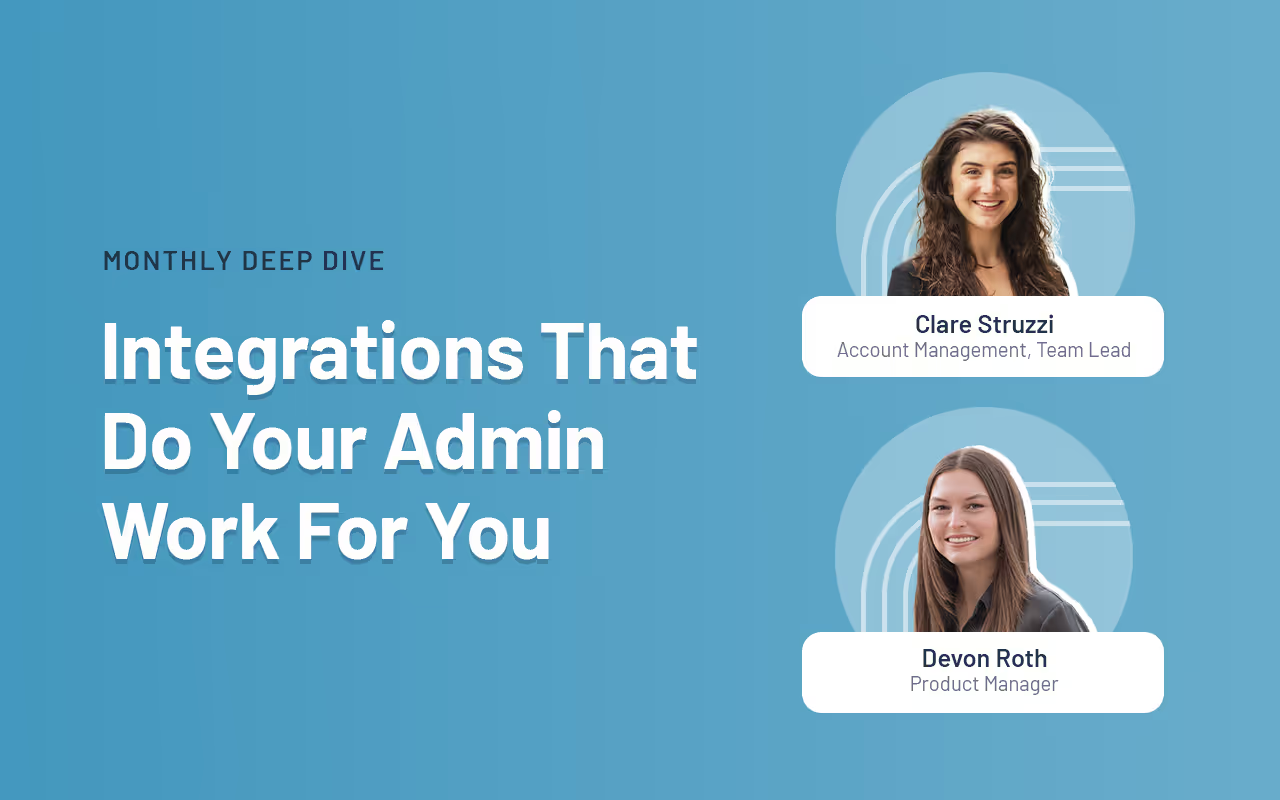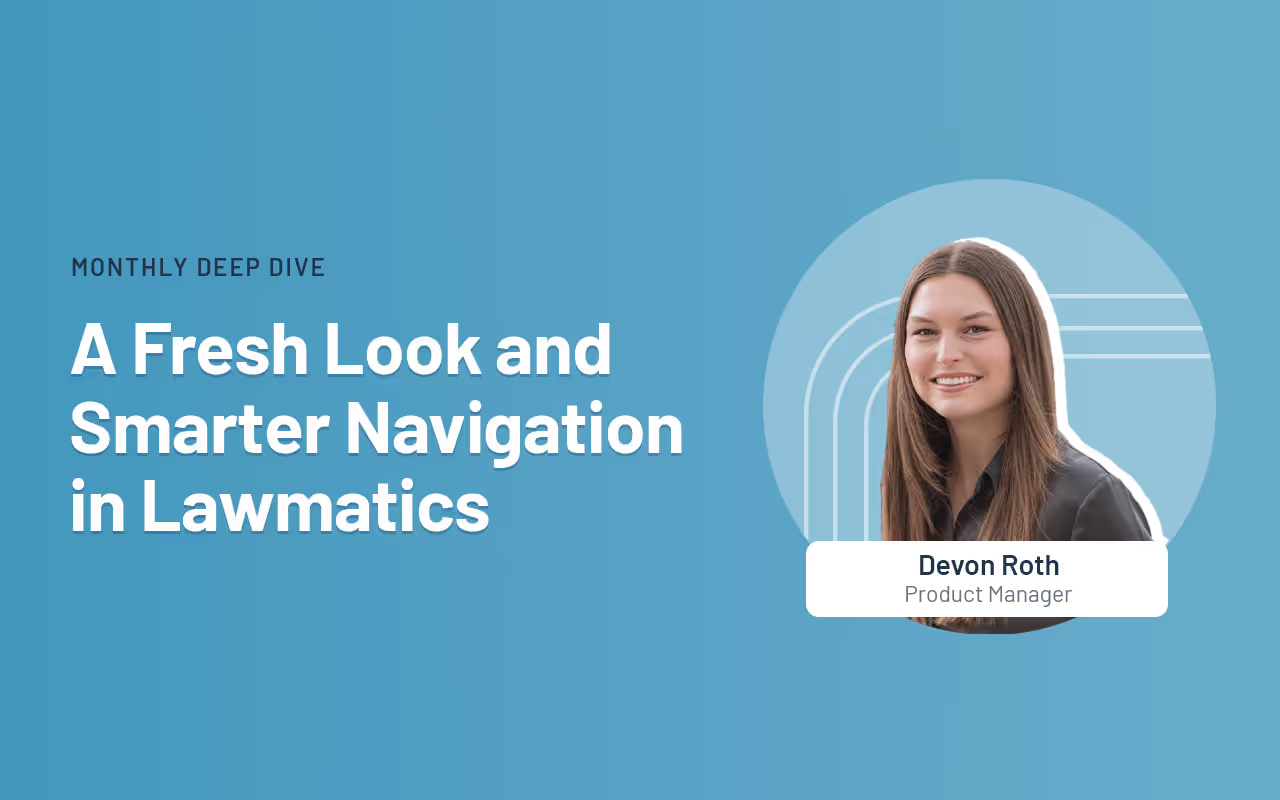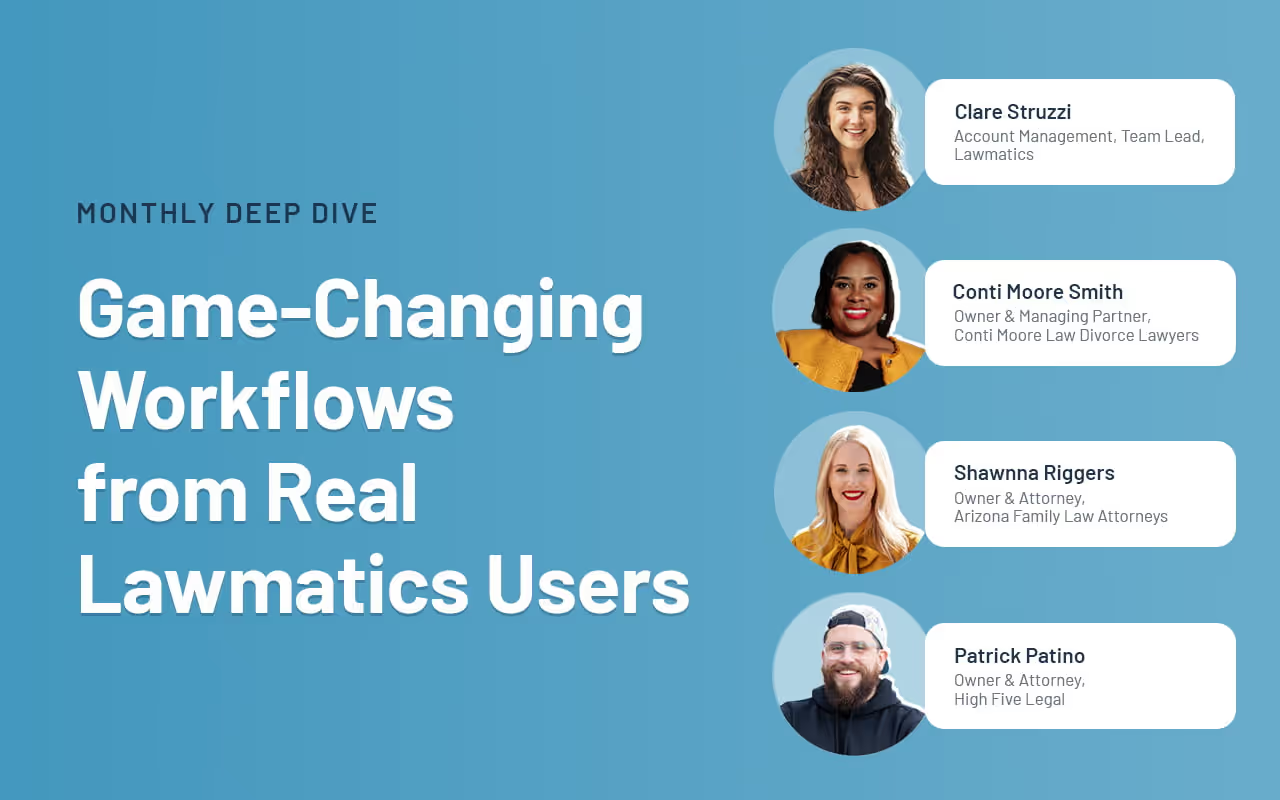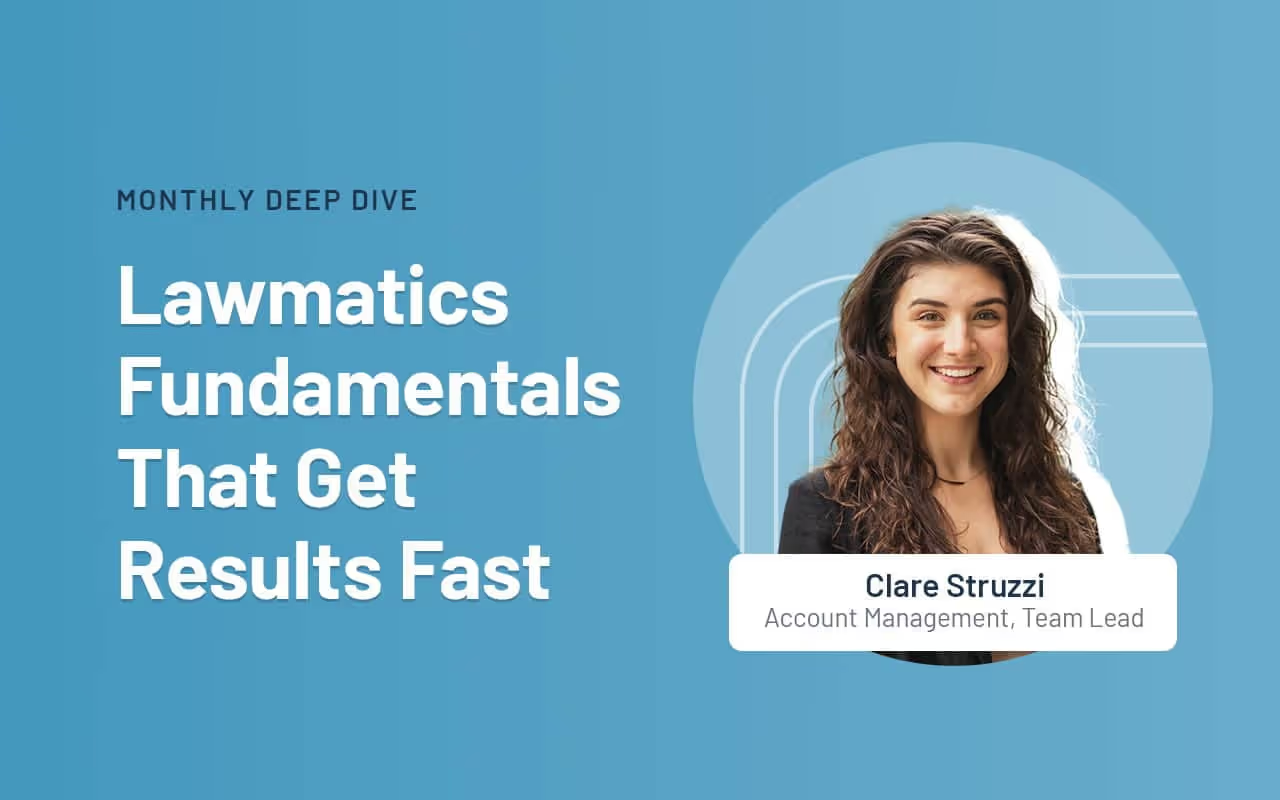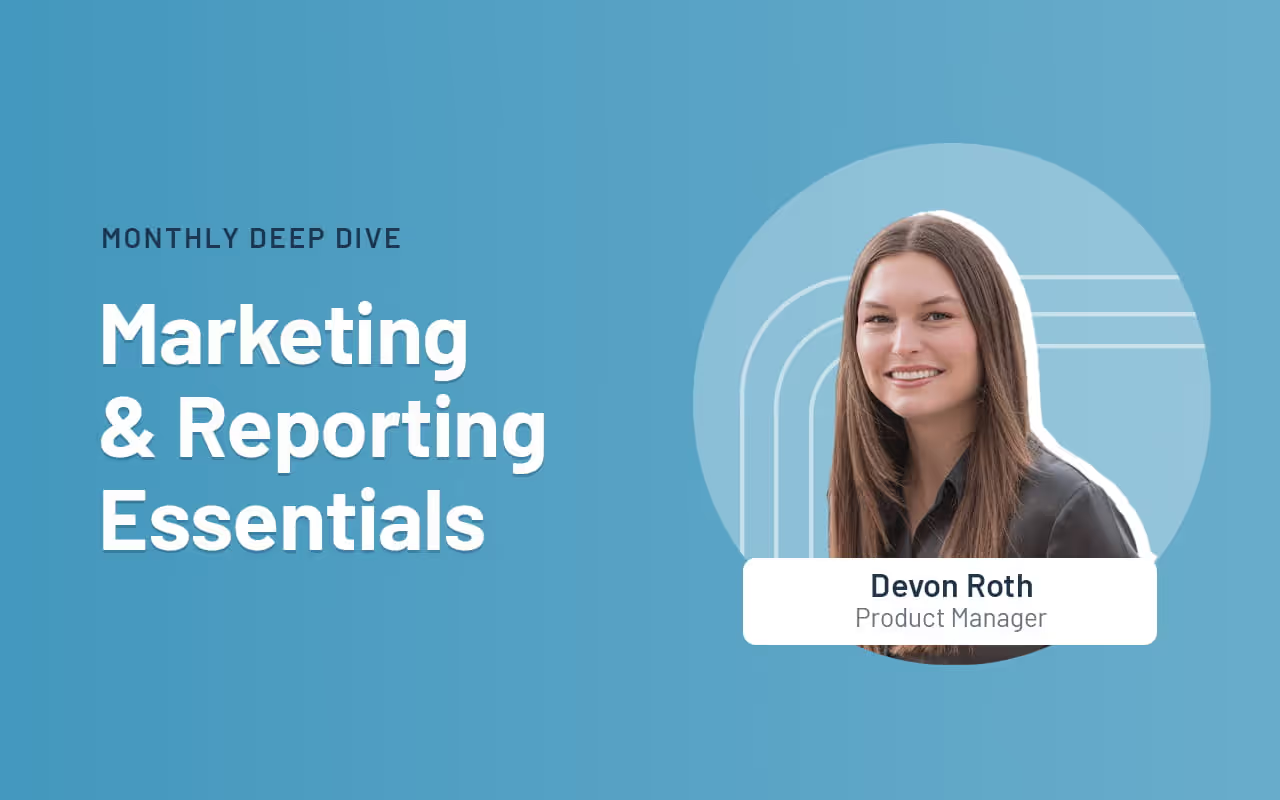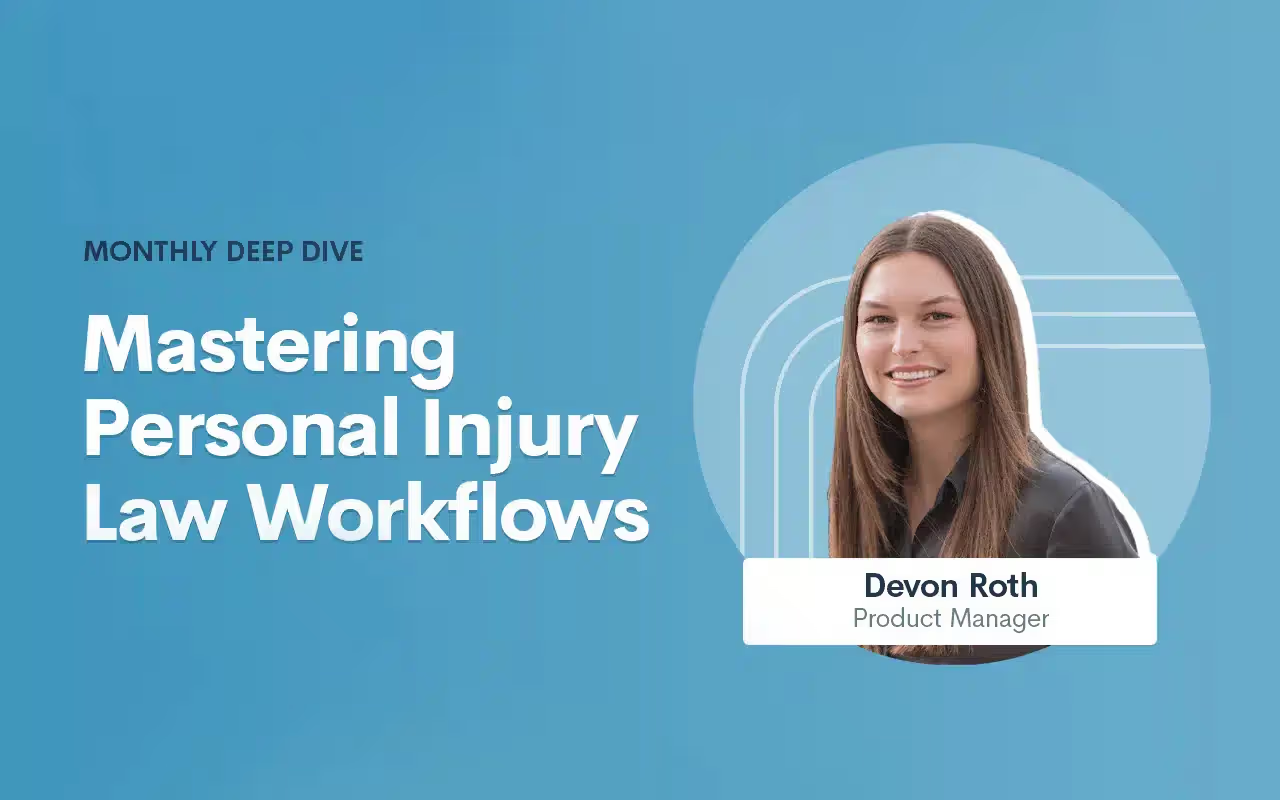Monthly Deep Dive
As we head toward the end of the year, our team revisited the most meaningful product updates of 2025 and how they’re reshaping the way firms work. All year long, our product work has centered on the same core goal: removing the obstacles that slow firms down. That’s meant bringing key information to the surface when teams need it, cutting out friction in the client journey, and giving staff clearer ways to build and maintain their processes across the platform.
Time stamps of key takeaways
8:15 – New, intuitive navigation
Devon walks through the redesigned navigation, which brings the most-used areas — like Matters, Pipeline, Calendar, Tasks, and Automations — into a cleaner, left-hand layout for quicker access. Reminders, emails, and other tools that had previously been scattered across the app now live in central, easy-to-find locations. The goal is simple: fewer clicks, clearer groupings, and a workspace that reflects how firms actually move through intake.
26:20 – Get key info faster with MMS
The team shows how firms can now receive MMS messages directly into Lawmatics, allowing clients to text photos or documents straight into their matter. It’s especially useful for practices like personal injury, where images of an accident or ID documents are often needed quickly.
31:18 – Manage your emails in one place
Email tools have been fully centralized, replacing the old model where templates lived in different corners of the app. Everything — from document send templates to automation emails — can now be created, edited, and organized in one place. Folders help firms manage growing libraries of emails, and each template can be applied across multiple documents without duplicate versions.
36:55 – Build and maintain automations with less effort
Devon and Clare highlight the refreshed automation experience, which makes appointment-based and date-based workflows easier to find, build, and understand. Relative timing is now built directly into each automation, and shared entry rules help firms avoid recreating the same logic dozens of times. Automation builds can also now be grouped in folders, similar to how you organize your email library.
45:18 – Additional highlights
The session closes with a handful of smaller but long-requested additions, including improvements to round-robin scheduling, password-protected forms, Message Center filters, auto-pay for billing, and color-coded appointment types to make dense calendars easier to read.
Webinar slide deck
Documents are a critical part of any legal intake, but they’re also one of the easiest places for things to get messy. Whether it’s missing information, outdated templates, or slow turnaround times, small issues can add up fast. That’s why it’s so important to have a document workflow that’s tightly connected to the rest of your process, especially when it comes to forms, automations, and e-signatures.
Hosted by Product Manager Devon Butler and Clare Struzzi, manager of the account management team at Lawmatics, the session walks through how to use Lawmatics to build dynamic documents, pull in the right data, and automate the intake process all the way through to a signed agreement.
Time stamps of key takeaways
7:15 – Creating a new document
Devon walks through how to build a document using the Start Fresh option in Lawmatics, which is the recommended editor. She covers everything from adding headers and footers to inserting merge fields and signature blocks. Clare also shares tips on how to handle formatting, like where to place page breaks and how to use conditional logic blocks effectively based on practice area, without needing separate documents for each.
21:00 – Customizing content with merge fields
In this section, Devon explains how merge fields pull in data from both the contact and matter to personalize each document. She shows examples like merging in retainer amounts, scope of representation, and current dates. Clare also highlights how firms often use consultation notes forms to pre-fill these fields, so everything’s ready to go by the time a document is sent.
29:32 – Sending forms / merging data from forms
Devon and Clare walk through how forms and documents work together. Using a form lets you collect the exact information needed to populate an e-signature doc, things like fees, payment plans, or incident details. They also cover when to set fields as required and explain when to trigger sends in an automation, as opposed to manually reviewing before sending.
36:18 – Internal vs external forms
Not all forms are built the same. Devon explains that internal forms can’t be sent via automation — even to internal users — so marking a form as external is key when it's part of a workflow. They also share how to pre-fill fields like lead attorney using hidden defaults, and how to time form delivery (e.g., sending to a lead attorney 10 minutes before a consultation) using appointment-based automations.
Webinar slide deck
Firms spend serious time and money bringing in new leads, but when it comes to knowing which efforts actually drive revenue, the picture is often fuzzy. Without reliable source tracking and clear reporting, it’s hard to tell where your marketing budget is paying off and where it’s getting wasted.In this month’s Deep Dive, Product Manager Devon Butler walks through how to set up and optimize marketing attribution in Lawmatics, from source creation to custom ROI reports and dashboards that help you make smarter, faster decisions.
Time stamps of key takeaways
8:13 – Set up marketing sources to start tracking
Devon begins in the settings page, where she demonstrates how to create a clean hierarchy of sources and campaigns. She highlights the importance of tracking costs for each source, from digital ads to referrals. This setup lays the foundation for accurate attribution and reporting later in the client lifecycle.
14:49 – How sources are assigned and tracked
Once sources are configured, Lawmatics automatically assigns them to new leads using form UTMs, CallRail tracking, or embedded snippets on your site. Devon breaks down how attribution is preserved throughout the client journey, from first click to hire. She also outlines common missteps, like missing UTMs or unlinked forms, that can cause breakdowns in source tracking.
24:17 – Monitoring ROI
The ROI Tracker gives a side-by-side view of each source’s leads, hires, revenue, spend, and return. Devon explains how the data flows directly from the marketing source setup and shows examples of real performance breakdowns. This report helps firms understand which channels are producing value and which ones aren’t.
36:18 – Creating a custom report and dashboard
To better understand what’s driving ROI, Devon builds a custom report that breaks down lead conversion by salesperson. She uses that as one example, noting that you can report on anything from practice area performance to time-to-hire. Once created, reports can be added to a dashboard so your most important metrics are always front and center, making it easy to track trends, spot issues, and share insights with your team.
Webinar slide deck
Intake is often the first real interaction a prospective client has with your firm — and the experience matters. The right form doesn’t just collect information; it sets the tone, guides the conversation, and lays the groundwork for everything that follows. That’s why building a single, thoughtful intake form can have an outsized impact on your workflow, your team’s efficiency, and how clients experience your brand from day one.To dig into what that looks like in practice, Lawmatics Product Manager Devon Butler teamed up with Clare Struzzi from our account management team for this month’s Deep Dive webinar. They covered everything from the fundamentals of form building to more advanced features like conditional logic and automation triggers.
Time stamps of key takeaways
7:00 – Custom form builder
Devon kicks things off with a walkthrough of the custom form builder, starting with the basics like naming conventions and form types. She also explains the different field types you can use (standard, contact, matter, company) and how to think about them when building a form that fits your intake process. The focus here is on creating something that’s both flexible and easy for your team to use consistently.
15:41 – Adding advanced elements
Devon and Clare go over enhancements like booking blocks, file uploads, and general form-only fields. General form-only fields live only on the form and don’t clutter up your matter pages — great for questions you don’t need to track long-term, like a detailed list of client assets. This portion also covers relationship blocks, perfect for collecting info for a client’s spouses or kids.
29:51 – Using conditional logic for smarter forms
Here, Devon introduces a key strategy: using conditional logic to tailor the form experience. Instead of overwhelming people with a wall of questions, you can have fields appear only when they’re relevant, like only showing spouse info when "married" is selected. Conditional logic is also a handy way to trigger follow-ups or route leads to the right next step, depending on how they answer.
37:02 – Trigger automations with form responses
Devon shows how you can connect your forms directly to automations. For example, if a consultation gets booked, an email or text confirmation goes out automatically. The key is using custom and standard fields to kick off the right workflow, so your team doesn’t have to remember to do it manually.
Webinar slide deck
Chasing down payments? Not exactly the dream when you started your law firm. Whether it’s prospects who never paid their consultation fee or leads dragging their feet on a retainer, the early stages of client onboarding can get bogged down fast. And when payment isn’t built into your intake process, it usually falls on someone’s shoulders to follow up, again and again.In this month’s Deep Dive, Lawmatics Product Manager Devon Butler walked through how to make payments a seamless part of your intake process. Joined by Sr. Director of Customer Success Johnny Bissell, she demoed how to add fees to forms, automate retainer collection, send receipts without lifting a finger, and keep tabs on every transaction along the way.
Time stamps of key takeaways
8:45 — Add consultation fees directly to your intake forms
Devon shows how easy it is to drag and drop a payment block onto your intake form using LMPay. You can set a flat fee, pick the bank account, and even use conditional logic to adjust pricing based on client responses. Johnny points out that this flexibility makes it simple to create one form that works for multiple appointment types.
15:41 — Collect retainers as part of your intake process
Need to collect a retainer before officially taking on a client? Devon walks through how to build that right into your automations — so once someone signs an agreement, the invoice goes out automatically. Johnny jumps in with ideas for customizing this based on package types or service tiers, making the process feel personal and polished.
32:43 — Automatically generate and send payment receipts
As soon as a payment is processed, Lawmatics can immediately send out a receipt. Devon shows how to tailor what’s included, like attaching the original invoice or just the receipt. It’s all handled behind the scenes, and yes, it waits until ACH payments actually clear.
35:07 — Monitor payments received from prospective matters
Keeping tabs on payments is simple with the invoices and activity views. Devon demos how to track what’s been paid, what’s still processing, and what might’ve failed. You can even issue refunds, if needed. Johnny notes that with the Time & Billing add-on, you can go even deeper, slicing your data by team member, payment method, or client type.
Webinar slide deck
Running a law firm means managing a lot of moving parts — from new inquiries and consultations to signed agreements and onboarding, let alone billable work. The more your pipeline grows, the more important it becomes to have systems that keep everything moving smoothly and nothing falling through the cracks. That’s where automation steps in — not just to save time, but to help you build a more scalable, conversion-ready intake process.In this month’s Deep Dive, Lawmatics Product Manager Devon Roth is joined by Clare Struzzi, manager of the account management team, to walk through how to get even more out of your automations and pipeline setup, so your firm can continue to grow.
Time Stamps of Key Takeaways
4:50 — Build an intentional pipeline
The webinar kicks off with Devon and Clare outlining how to build a clean, intentional intake pipeline that works across all practice areas. Rather than juggling multiple pipelines, they recommend one universal structure with milestone-based stages. Clare also shares tips from onboarding calls about using filters and tags to keep it flexible without adding complexity.
9:22 — Automate key workflows
In this section, Devon demonstrates how automations can replace manual tasks — like sending emails, changing statuses, or converting leads — so your team can focus on high-touch client work. The takeaway: Automation isn’t just about speed — it’s about setting your firm up to scale responsibly.
27:00 — Using triggers and actions
This section covers the full automation lifecycle, from what sets a workflow in motion to what happens next. Devon breaks down key trigger types like form submissions, document completions, and field updates, then transitions into a demo of how to stack actions such as emails, tasks, delays, and conditionals. Clare adds strategic context around using advanced logic, testing automations with dummy matters, and avoiding common missteps.
43:59 — Exit conditions and next steps
In the final segment, Devon and Clare demonstrate how exit conditions ensure automations stop when a lead hires, is lost, or moves forward, preventing redundant follow-ups. A key example is the engagement agreement: Once it’s signed, Lawmatics can automatically convert the lead to a hired matter, trigger a welcome packet, and end any drip campaigns still running. Your hosts wrap by emphasizing the importance of sub-statuses for tracking lost leads and using conversion actions to maintain clean data and syncs across systems.
Webinar slide deck
Running a law firm means juggling a million moving pieces — marketing, client communication, team workflows, and of course, getting paid. Wouldn’t it be nice if more of that just... took care of itself? In our latest Deep Dive webinar, we shared some exciting new features designed to do just that.Your hosts, Lawmatics Product Manager Devon Roth and Sr. Director of Customer Success Johnny Bissell, walked through the newest and upcoming features designed to help law firms work more efficiently and drive growth. From enhanced marketing integrations to improved communication tools and smarter financial workflows, these updates are built to make a real impact on your firm’s success.
Time Stamps of Key Takeaways
9:00 — Google ads integration improvements
Google Ads integration has been enhanced to automatically import UTM values from your ad campaigns. This means that instead of manually tracking and entering UTM data, Lawmatics will now capture it automatically and sync it to your marketing sources. Additionally, Google Click IDs (GCLIDs) are now supported, allowing for more precise conversion tracking.For firms investing in Google Ads, this update eliminates the hassle of manually tracking ad performance. With automatic UTM imports and GCLID tracking, firms can send offline conversion data back to Google via Zapier, providing a clearer ROI picture for paid campaigns.
16:18 — MMS messaging
One of the most highly requested features, MMS messaging, is coming soon to Lawmatics! While firms have long been able to send and receive standard text messages, this new functionality allows clients to send images directly via text. This is particularly valuable for personal injury and family law firms, where clients frequently need to share accident photos, medical documents, or other case-related images.
23:25 — User activity reports
To enhance firm oversight and productivity tracking, Lawmatics is introducing User Activity Reports. These reports will log every action taken by every user, including emails sent, SMS activity, document shares, appointments scheduled, and more. With filtering options by user, action type, and date range, firms can quickly analyze performance, identify trends, and optimize workflows.
33:14 — Surcharging
For firms using LMPay Version 2, a new surcharging option allows firms to automatically add a 3% processing fee to credit card transactions. This helps firms offset processing costs without increasing service fees for all clients.
Webinar slide deck
Running a law firm means juggling a lot of moving pieces — client communications, case details, marketing efforts, and scheduling, just to name a few. Without the right tools working together, things can get messy fast. That’s where Lawmatics integrations come in. Instead of wasting time on duplicate data entry or switching between disconnected platforms, you can automate key processes and keep everything in sync.In our latest Deep Dive Webinar, Lawmaticians Devon and Clare walked through how these integrations make day-to-day operations smoother, from keeping calendars updated to tracking marketing performance. Let’s break it down.
Time Stamps of Key Takeaways
0:00 — Why integrate?
Devon and Clare kick things off with an overview of how integrations generally work, and a glimpse at the full library of native Lawmatics integrations. They outline how integrations can really take the busywork out of your day to day, keeping everything in sync, from case management and marketing to client communication.
9:39 — User integrations
Devon and Clare dive into user integrations, which sync applications with Lawmatics for individual users within your firm. Email sync automatically logs client messages and attachments in Lawmatics, reducing inbox clutter and keeping communications organized. Calendar sync prevents scheduling conflicts by updating availability in real time. The Zoom integration ensures virtual meetings are seamless by generating and embedding links directly into invites. Since these are user-specific, each person needs to enable them individually, but once set up, they make day-to-day tasks far more efficient.
20:44 — Call integrations
Law firms handling high call volumes can track and manage inbound and outbound calls directly within Lawmatics. The RingCentral integration enables outbound calls directly from a matter, while also logging inbound calls for easy reference. CallRail takes tracking a step further by offering recorded call playback and marketing insights, allowing firms to analyze call performance.
28:23 — Case management integrations
Lawmatics integrates with leading case management platforms to ensure a smooth transition from intake to ongoing case work. Our hosts took a closer look at how Lawmatics syncs with Clio Manage, automatically transferring client and matter details, documents, and notes at the point of conversion. They also discuss some of the differences between our integrations with some of the other popular case management systems.
37:42 — Marketing integrations
Law firms need clear insights into where their best leads are coming from, and Lawmatics integrations make that easy. The Google Ads integration pulls campaign data and ad spend directly into Lawmatics, helping firms measure return on investment without jumping between platforms. (Devon also teased upcoming improvements to this integration!) CallRail plays a role here, too, by tracking call sources so firms know exactly which campaigns are driving inquiries.
41:00 — For everything else, there’s Zapier
When a direct integration isn’t available, Zapier fills the gap by connecting Lawmatics to thousands of additional applications. Whether linking with Calendly for scheduling, Google Sheets for tracking, or various case management and payment platforms, Zapier automations work like Lawmatics workflows — triggering actions to keep data in sync.Check out our entire catalogue of integrations at lawmatics.com/integrations.
Webinar slide deck
Kicking off the year with a bang, we’ve introduced a fresh, intuitive user interface built for you! From reorganizing your favorite tools to creating a more intuitive workflow, this redesign is designed to save you time and simplify your day-to-day. We know change can be exciting — and maybe a little daunting — which is why we couldn’t wait to walk you through the new Lawmatics interface. Let’s get straight into it.
Time Stamps of Key Takeaways
0:00 — Why the new look?
Your host, Lawmatics Product Manager Devon Roth, kicked things off with a walkthrough of why we’ve revamped the UI. This redesign is all about making things easier for you. We’ve streamlined the layout, made the interface more intuitive, and focused on functionality — so you can spend less time clicking and more time doing.
9:39 — New tabs on the side navigation
Dashboards, Matters, and Pipelines are now just a click away with new tabs on the side navigation — no more digging through menus! We also gave Dashboards its own special tab outside of the Lawmatics logo, so it’s quicker than ever to check in on your numbers.
12:58 — Automations and reminders reorganized
Our previous interface sometimes required users to hunt through different locations in the app to set reminders for specific moments in the client journey. But good news: You can now manage all your reminders in one place under the new Reminders tab. You'll also notice that all of your automations can now be found under the new Workflows subtab.
16:22 — Marketing made more intuitive
The new Marketing tab is organized to follow the flow of your campaigns, from building email templates to selecting audiences and launching your outreach. We also regrouped event management tools here since seminars and webinars are often key to attracting new clients. Previously, these tools were part of the CRM tab, but this update brings together all marketing-related features into one place.
27:43 — People at the center
Just like Marketing, the People tab includes features that were previously grouped under the old CRM heading. We’ve restructured and decluttered this section, making it easier to navigate. Whether you’re adding new contacts or updating existing ones, the streamlined layout helps you quickly find what you need.
29:09 — Docs & Forms
This tab is your one-stop shop for receiving and sharing information with your clients, whether it’s intake forms, e-signatures, or file requests. It’s also the home of other firm files that were previously grouped under the old Assets tab, like premade welcome packets for new clients.
32:13 — Q&A and recap
We left plenty of time to talk through questions about all the changes in the new interface. Devon touched on the Reports and Time & Billing tabs, which remain largely unchanged, and clarified where to find tools that might have moved. It’s a great segment to watch if you’re wondering, “Wait, where did that feature go?” We also shared tips to help you make the most of the updates and collected feedback for future improvements.
Webinar slide deck
Using Lawmatics is like owning a high-performance sports car—it’s engineered to deliver speed, precision, and efficiency. And the real magic happens when you push the limits and discover just how much it’s capable of. This month’s webinar zeroed in on five features that can elevate your workflows, helping you go faster, work smarter, and drive greater profitability at your firm.From automated conflict checking to ROI tracking and targeted marketing campaigns, these tools aren’t bells and whistles; they’re the difference between coasting and cruising at full throttle. Whether you’re looking to simplify day-to-day operations or rapidly grow your firm, this session was packed with strategies to make it happen.
Time Stamps of Key Takeaways
5:39 — Manual and automated conflict checking
To kick things off, Devon breaks down how both manual and automated conflict-checking options can safeguard your client intake and case management processes. Through clear, real-world examples, she shows how automations not only reduce risk but also save you hours of repetitive work
17:48 — Document templates and one-offs
Next, Devon introduces the powerful document creation tools within Lawmatics. From building time-saving templates to sending one-off documents, she highlights how these features help to maintain consistency and save time in your client communications.
31:31 — Tracking return on investment (ROI)
Devon highlights the ROI tracker, a powerful tool that turns your data into actionable insights. With a clear view of your return on investment, you’ll gain the upper hand in evaluating your marketing efforts and driving smarter business decisions.
37:17 — Create targeted market campaigns
Devon then dives into the marketing suite in Lawmatics, emphasizing the creation of targeted marketing campaigns that resonate with your audience. With practical tips on leveraging data and built-in features, she demonstrates how to refine your strategies and connect with your ideal audience more effectively.
45:48 — Event management
Devon wraps up this webinar by going over event management capabilities within Lawmatics. She details how users can organize and manage events seamlessly, leveraging tools that allow for event tracking and integration with other features to ensure smooth operation.
This month, we’re pulling back the curtain on the workflows and go-to tools that help three attorneys — and Lawmatics power users — run their firms with efficiency. These experts share their secrets to mastering three critical stages of the client journey: attracting qualified leads, nurturing them into clients, and onboarding new clients seamlessly.In this exclusive roundtable, our panelists dive deep into what’s driving results for their firms, offering practical insights and actionable tips that any attorney can use to streamline operations and accelerate growth.
Panelists

Clare Struzzi
Account Management Team Lead,Lawmatics

Conti Moore Smith
Owner & Managing Partner,Conti Moore Law Divorce Lawyers

Shawnna Riggers
Owner & Attorney,Arizona Family Law Attorneys

Patrick Patino
Owner & Attorney,High Five Legal
Time Stamps of Key Takeaways
3:55 — Attracting quality leads with precision
When it comes to client intake, precision is the name of the game. The self-styled ‘MacGuyver of Law Firms’ Patrick Patino shares how High Five Legal leverages the Lawbrokr integration with Lawmatics, in conjunction with Lawmatics custom forms, to ensure only the most qualified leads make their way to his desk. Think of it as a finely-tuned filter, separating the gold from the gravel.
14:30 — Nurturing leads and sealing the deal
Once the custom forms have filtered through qualified leads, it's time for automation to take over. Patrick showcases how Lawmatics automations keep leads engaged through timely follow-ups, personalized communication, and relevant content. This nurturing process ensures that leads stay warm and continue to move seamlessly through your pipeline, ultimately leading to that important final step — hiring your firm.
20:00 — Automatic engagement and data population
Shawnna presents the custom form her team uses to capture comprehensive client data and personalize the intake process. Once submitted, Lawmatics automatically generates and sends engagement agreements, streamlining the initial client onboarding. For clients still deciding, the system enrolls them into an email nurture campaign featuring informative videos and resources to guide their next steps.
28:26 — Phone intake and booking calendars
Shawnna hands things over to Jordan Douglas, the firm’s new client coordinator. She sheds light on features used by the intake team, beginning with an internal intake form used during phone consultations. One of Jordan's favorite features is the self-serve booking option on these forms, which helps set client expectations in real-time during the intake call regarding attorney availability. This form also includes fields essential for operations, such as referral source tracking and space for additional notes.
37:28 — Onboarding made excellent and efficient
Conti Moore dives into her process for onboarding clients after they’ve decided to hire the firm. It all starts with an automated fee agreement and extends to paying retainers, sending final onboarding forms, and generating invoices. This considered approach ensures a smooth onboarding experience for new clients who are still learning to trust their new attorneys.
48:56 — Adapting automations for client journeys
Conti is joined by Marko Skarica, a digital marketer and developer who helped set up the firm’s automations, who demonstrates how the firm can adapt and build new automations to accommodate every step toward retaining the firm — regardless of the client journey. For example, Conti Moore Law offers DIY courses for prospective clients who may not currently afford an attorney. These leads are supported with their own automated drip campaigns designed to transition them into paying clients should they later decide to hire an attorney.
Let's face it: A disorganized practice can feel like herding cats while juggling flaming torches. Missed appointments, paper trails that go nowhere, and potential clients slipping through the cracks are common stress points that keep you up at night. Our recent Deep Dive webinar was all about how we can tackle these challenges together.Whether you're new to Lawmatics or just looking to sharpen your skills, this webinar showed how mastering the basics of our CRM can make a monumental impact on your practice. Imagine slashing intake times in half, reducing no-show rates, and converting leads twice as fast. That's the kind of game-changing efficiency we’re talking about!
Time Stamps of Key Takeaways
0:00 — Getting started
Meet your host, Clare Struzzi! Clare is our account management team lead, and an expert at getting law firms up and running on Lawmatics. Here, she outlines the agenda for the session, which is to recreate a typical first onboarding session for new Lawmatics customers.
5:47 — General settings
The general settings page is always the place to start with a new account. Clare starts with user settings like creating your email signature and connecting your calendar. Then, she moves into firm settings, where your firm’s chief Lawmatics user can fill in practice-specific information, like office locations and branded document headers.
18:55 — Organizing the pipeline
The pipeline is what keeps a prospect moving through the intake process, from marketing all the way to signing their engagement agreement and beyond — so it’s important to spend time making sure it’s built for your firm’s needs. Clare shows how to create each stage of your pipeline, and even create different pipelines for each of your firm’s practice areas.
29:39 — Appointments and events
Next, Clare walks through how to create appointment types, from setting the duration of each meeting type to the default rate the firm will charge for each. Then, she uses the email builder to write reminder and confirmation messages for these appointments, incorporating custom fields that tailor each message to each client.
44:00 — Phone intake form
Forms are an invaluable tool for collecting information about your clients and matters. In this final section, Clare builds an example of a form an intake specialist would use for intake by phone. She explains the differences between standard and custom fields, as well as how to make forms dynamic by incorporating options like a self-service booking calendar at the end of the form.
You wouldn’t set sail without a course—so why run a law firm without any clear KPIs? Custom dashboards are your navigational charts, guiding you through the sea of data toward smarter, more strategic decisions.In the latest Deep Dive Webinar, Product Manager Devon Roth delves into how these custom dashboard data visualizations can revolutionize your law firm's efficiency. This session covers everything from building new custom dashboards for immediate data access to tailoring them for showcasing the metrics that matter most, all aimed at enabling better operational decisions with actionable data insights.
Time Stamps of Key Takeaways
0:00 — Getting started
The webinar kicks off with an explanation of how custom dashboards differ from our legacy dashboard, and how you can alternate between the two. Devon also outlines some of the key (and surprising!) benefits of customizing your dashboard layout, from boosting client engagement to tailoring your marketing strategy.
6:17 — Choose your panel types
Devon first surveys all of the different panels firms can use to organize their information. Firms use these panel types to review things like notes, tasks, upcoming appointments, outstanding e-signatures, and more. She then offers a demonstration of how to format the page, resize panels, and even divide your dashboard layout by practice area.
18:55 — Understanding panel visualizations
Next, Devon focuses specifically on the data panel. From conversion rates to the value of cases in your pipeline, these analytical indicators are the cornerstone of guiding your firm toward increased profitability. She demonstrates a few panel setups that enable you to keep an eye on the intake pipeline, ensuring no potential client gets stuck between stages.
24:08 — How to use reports on dashboards
While some of the other panel types only show standard fields, data panels can pull insights from any of your custom matter reports. In this section, Devon walks through how to set up data visualizations that show the specific granular criteria you need to keep front and center for your firm.
42:31 — Organizing group panels
Finally, Devon quickly shows the click-and-drag customization options with the group panel type. You can select any panels already on your custom dashboards and bunch them together, grouping insights by practice area, matter type, or time period.
Marketing and reporting are the key drivers of a law firm's profitability. But how do you ensure your marketing efforts hit the mark and your reports provide actionable insights? Join Lawmatics Product Manager Devon as she guides you through the essentials of optimizing your marketing efforts using Lawmatics. From creating stunning HTML emails that captivate clients to precisely segmenting your audience for targeted campaigns, Devon provides a step-by-step guide to revolutionize your approach.
Webinar Timestamps
0:00 — Why use Lawmatics for marketing and reporting?
Devon kicks off the webinar with an overview of why Lawmatics stands out as a game-changer for law firms when it comes to marketing and data insights.
4:54 — How to build and edit an email using HTML templates
Devon’s first product demonstration focuses on the HTML email builder and editor. She shows how users can start with a blank canvas or customize pre-built templates to meet the specific design and branding needs of any firm.
10:00 — Create audiences based on types of marketing emails
Next, Devon discusses how creating specific audiences enables better-targeted marketing campaigns. This segmentation ensures your content reaches the most relevant audience, boosting engagement and conversion rates.
15:34 — Schedule campaigns to be sent out
Effective marketing is often about timing. In this segment, Devon walks through the step-by-step process of scheduling emails to be sent at optimal times, ensuring your message hits your audience when they’re most likely to engage.
21:05 — Create custom reports
Understanding your marketing performance is crucial, and Lawmatics custom reports let you dive into the metrics that matter most. Devon shows how to generate these reports based on different fields, offering insights that help you track success and pinpoint areas for improvement.
41:45 — Add custom reports to your custom dashboards
To wrap up this month’s Deep Dive, Devon incorporates the custom reports into a personalized dashboard. This fully customizable data hub gives you a comprehensive view of your firm’s performance, from marketing ROI to task management efficiency.
In the high-stakes world of criminal defense, where every move can change a client's future, streamlining your workflows is more than essential—it's critical. Imagine being able to respond promptly to every client's needs without pulling focus from their matters or that of your other clients. Our latest Deep Dive Webinar showcases the power of criminal defense workflows in Lawmatics, making it easy to disengage unqualified leads and win more clients with impactful marketing campaigns. Host and Lawmatics Product Manager Devon Roth demonstrates how to build and implement this workflow in your own practice, ensuring you take timely action and accurate insights.
Webinar Timestamps
0:00 - Introduction and overview
Devon opens the webinar by outlining the focus on mastering criminal defense workflows in Lawmatics, covering housekeeping items, and briefly introducing herself and Erika from the customer success team.
5:36 — Criminal defense Automations
Devon gives an overview of the Automations typically used in a criminal defense practice. Her example workflow includes drip campaigns for leads who haven’t scheduled a consultation, appointment reminders and follow ups, and exit conditions to end follow up campaigns.
15:16 — How to automatically disengage unqualified leads
Not every lead is going to fit your firm’s client profile. In this section, Devon demonstrates how to use Automations to swiftly disengage those disqualified leads after a consultation. She also previews how to build Automations for clients who are undecided, may wish to retain your services at a later date, or are referred out to a law firm better suited to handle their matter.
27:38 — Tailor marketing campaigns for maximum impact
Targeted campaigns for segmented audiences are an effective way to engage prospects and both old and new clients. Here, Devon shows how to create branded HTML emails and incorporate them into drip campaigns to keep your firm top of mind no matter the stage of the client journey.
33:23 — Analyze and report on firm metrics
Understanding your data is critical to running an efficient and profitable criminal defense practice. This section exhibits how to build custom reports based on any field in your Lawmatics CRM and how to incorporate these helpful reports into custom dashboards for actionable visualizations.
35:50 — Create follow ups based on court dates
Automations are key to staying on top of court dates and ensuring no deadlines are missed. Devon wraps up this Deep Dive with a guide to creating date-based Automations, like reminders based on court appearance dates or other key points in your client’s matter.
Personal injury cases are more than legal battles—they're a pivotal chapter in a client’s life, often fraught with physical, emotional, and financial turmoil. With that in mind, the latest installment of our Deep Dive Webinar series showcases a fully automated workflow tailored for personal injury practices. Host and Lawmatics Product Manager, Devon Roth, demonstrates how to build and implement this workflow in your own practice to not only boost efficiency and reduce errors but also ensure that every client receives best-in-class care and support throughout their legal journey.
Webinar Timestamps
0:00 - Introduction and overview
Devon opens the webinar, introduces the focus on mastering personal injury workflows in Lawmatics, covers housekeeping items, and provides brief personal introductions for herself and Erika from the customer success team.
4:50 - Personal injury law automations
Devon gives an overview of the Automations typically used in a personal injury practice. Her example workflow includes intake processes for leads that contact your firm both through the web and phone. She also demonstrates how to use custom forms to collect practice-area-specific fields, like insurance documentation or incident photos.
18:00 — Appointments, emails, and e-signature
Continuing down the intake process, Devon shows the next steps in the personal injury client journey after they’ve been contacted by the firm. She uses Automations to prompt leads to schedule consultations, notify leads that they may not qualify to work with the practice, and share the engagement agreement.
30:48 — Staff review, undecided status, and welcome emails
Next, Devon demonstrates how Lawmatics is adaptable to different client situations. Successfully hired clients can be welcomed with an automated email welcoming them to the firm, and outlining next steps. Lawmatics can also flag matters in need of staff review, and monitor the status of potential clients who have yet to make a decision on representation.
35:30 — How to track referrals in and out
Devon discusses setting up Automation for tracking referrals of potential clients. By updating specific custom fields, users can ensure that referrals are accurately tracked in their records. This system can provide valuable insights for reports and help monitor the success of referral partnerships.
40:15 — Reporting on matters and referrals
In this section, Devon breaks down the analytics page, and demonstrates how to create custom reports for referrals. Filters can be applied to show matters specific to a practice area, such as personal injury, and to track referrals from specific sources. The report can also include additional columns for tracking status, substatus, and grouping referrals by the person making the referral.







